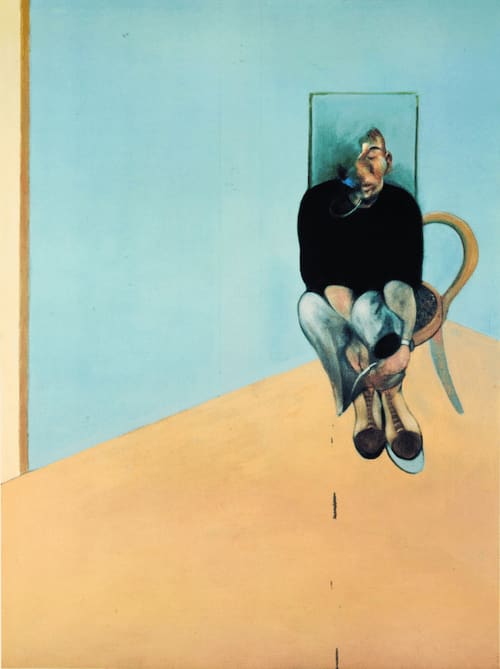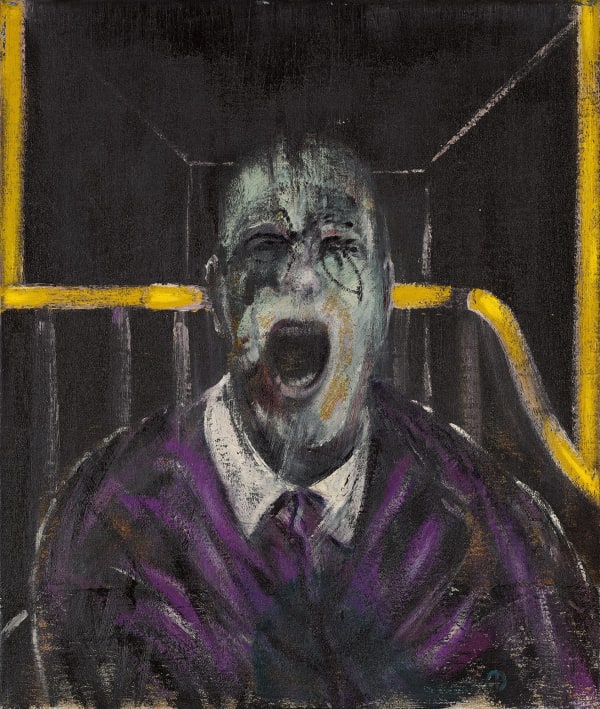-
Francis Bacon Prints For Sale.
Francis Bacon's art is a deep exploration of the human condition told through the revolutionary lens of a true genius. His distorted and contorted figures explore aspects religion, mythology & the deeply personal. Explore our latest Francis Bacon prints for sale at Guy Hepner, Bacon dealers since 2007.
Discover authentic Francis Bacon signed prints for sale below.
-
Works

Francis Bacon
Study for Self Portrait , after Study for Self Portrait 1982, 1984Offset lithograph on Wove paper37 1/8 x 25 5/8 in
94 x 65 cmEdition of 182Copyright The ArtistFrancis Bacon’s After Study for Self-Portrait presents a striking shift in tone from the raw, convulsive energy that characterizes much of his earlier work. Here, the figure—presumably Bacon himself—is seated...Francis Bacon’s After Study for Self-Portrait presents a striking shift in tone from the raw, convulsive energy that characterizes much of his earlier work. Here, the figure—presumably Bacon himself—is seated in a pose that feels less tortured and more contemplative. The body language is relaxed, almost meditative, set within a liminal, undefined space that resists any specific temporal or spatial anchoring. The palette, composed of soft blues and sandy yellows, imparts a sense of calm introspection rather than existential violence.
Throughout his career, Bacon frequently placed his figures within rigid geometric structures—frames, boxes, and architectural enclosures that heightened the sense of psychological and physical confinement. In this print, however, those formal barriers have softened, if not dissolved entirely. The figure seems suspended in a space that is open yet quietly bounded—more suggestive than architectural. This visual openness implies a loosening of internal constraints, replacing earlier sensations of claustrophobia with a more reflective, introspective atmosphere.
The composition still retains some of Bacon’s hallmark traits: the chair, the subtle framing devices, the isolated figure. Yet these elements are presented with a newfound restraint. The figure is not howling or writhing in anguish; rather, it appears absorbed in thought, caught in a moment of stillness that is rare in Bacon’s oeuvre. This softening is echoed in the gentle tonal contrasts and the almost pastel-like handling of color, which shift the emotional register from violent confrontation to subdued rumination.
This quieter mood does not signal an abandonment of Bacon’s core themes. Rather, it suggests an evolution in how he engages them. The face, as in many of his self-portraits, remains slightly blurred, partially erased—its features indistinct and ghostlike. This loss of clarity does not obscure identity; instead, it reinforces Bacon’s meditation on impermanence, time, and the erasure of the self. The ambiguity of the features invites the viewer to reflect not only on Bacon’s identity, but on the ephemeral nature of existence itself.
Though less overtly brutal than his earlier works, After Study for Self-Portrait remains haunted by Bacon’s preoccupations with mortality, decay, and the disintegration of the self. The soft edges and desaturated tones may suggest a gentler engagement with these ideas, but they do not lessen their emotional weight. Instead, they allow for a more intimate, even tender confrontation with the fragility of life. There is no dramatic collapse or scream here—just the quiet, persistent hum of transience.
The relaxed pose and subtle gestures further underscore this introspective tone. The figure does not resist its environment but inhabits it. This sense of psychological surrender—of acceptance, perhaps—marks a departure from the raw urgency of Bacon’s earlier self-portraits. It is as if, later in life, the artist has turned from external conflict to internal reckoning. The absence of overt violence does not suggest peace, but rather a deep, contemplative understanding of the body and self as mutable, aging, and finite.
In this light, After Study for Self-Portrait can be read not as a diminishment of Bacon’s intensity, but as a refinement of his vision. It captures a quieter form of existential reflection—no less powerful, but more meditative in its approach. The work continues to grapple with the artist’s enduring themes—mortality, identity, and the passage of time—yet it does so with a sense of dignity and restraint, as though the figure has ceased struggling against the void and begun to coexist with it.
Ultimately, this self-portrait speaks to the late phase of Bacon’s artistic journey. It is less a scream than a murmur—no less poignant, and perhaps more profound. It invites the viewer not into a spectacle of anguish, but into a quiet space of contemplation, where the distortions of the flesh and the soft dissolution of identity gently echo the universal truths of aging, memory, and the inevitable fading of self.
For more information on Francis Bacon’s After Study for Self-Portrait or to buy After Study for Self-Portrait contact our galleries using the form below.Overview"The job of the artist is always to deepen the mystery".
Francis Bacon is one of the most important artists of the 20th century and post-war movements. Arguably one of the finest and most celebrated artists of his generation, Bacon holds a pivotal role in contemporary art through his revolutionary approach to his craft. One of the great explorers of the human condition Francis Bacon and his art, touch on fateful mix of mythology, religion, love and death, and document our joys, sorrows and pains perhaps better than any other artist before or since.
The imagery of Bacon is one of pure expression rejecting the prevailing artistic style of abstraction of the era, in favor of a distinctive and disturbing realism and his distorted forms convey a sense of both beauty and despair. The dichotomy in Bacon’s prints and imagery can be seen through his raw use of violent, yet delicate colors as well as the marriage he makes between the figurative and abstract. It is this soft balance between the brutal and the subtle, the violent and the soft and happiness and anguish that make Francis Bacon’s art so important and collectible. A master of painting, and known for his large scale canvases, Bacon combines seemingly disparate tectures, colours and forms to ceate a whirlwind of emotion conveying and reaching the heart of his subjective matter. Equally so Franci Bacon's print output, often as apres, lithographs or signed prints, offer his most popular subjects including Pope Francis and his famous triptychs.
Whether new to collecting Francis Bacon prints or an experienced collector, Guy Hepner can help. Since 2007 we have assisted clients across the world to buy Francis Bacon prints in confidence. Whether iconic triptych, lithographs or apres, our experienced and knowledgeable team are on hand to help you achieve your collecting goals. From our New York and London galleries, offer a wide selection of authentic Francis Bacon prints for sale.
Contact info@guyhepner.com for our latest Francis Bacon prints for sale or to buy Francis Bacon original art. News
News-

London’s Frieze Week Record Breakers
A Guide to a Blockbuster Week of Sales October 20, 2025London’s marquee auction houses just concluded a blockbuster week of contemporary art sales, coinciding with the Frieze art fair. In a series of evening auctions...Read more -

A Collector’s Guide to Francis Bacon Prints
Why Collect Bacon March 14, 2025Francis Bacon remains one of the most powerful and influential artists of the 20th century. His raw, visceral works depicting the human form in distorted,...Read more




